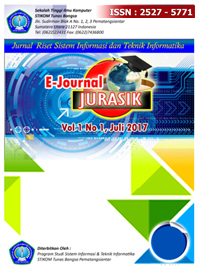Pengenalan Emosi Ucpan Berdasarkan CMARS dan SVM
Abstract
Pengolahan data berdimensi tinggi merupakan permasalahan klasik dalam bidang penelitian pengenalan emosi ucapan, pengurangan ekstrak fitur dan model pengenalan emosi ucapan merupakan bagian terpenting. Makalah ini memilih fitur emosional yang valid dan mengekstrak nilai statistik fitur emosional. Model pengenalan emosi ucapan dibangun berdasarkan CMARS dan SVM efek pengurangan fitur masing-masing pada dua jenis model dibandingkan. Hasil eksperimen menunjukkan bahwa, berdasarkan fitur-fitur emosi yang diekstraksi dari dataset atau korpus emosi RAVDES memperoleh model terbaik dengan perolehan nilai 97% tingkat akurasi atas pengaruh variabel independen terhadap variabel dependen, pengurangan fitur dapat meningkatkan akurasi pengenalan dan efek pengenalan, model pengenalan emosi ucapan berbasis CMARS lebih baik dari pada SVM.
Full Text:
PDF (Bahasa Indonesia)References
. Handoko, I. T., & Suyanto, S. (2019). Klasifikasi Gender dan Usia berdasarkan Suara Pembicara Menggunakan Hidden Markov Model. Indonesia Journal on Computing (Indo-JC), 4(3), 99-106.
. Egger, M., Ley, M., & Hanke, S. (2019). Emotion recognition from physiological signal analysis: A review. Electronic Notes in Theoretical Computer Science, 343, 35-55.
. Daneshfar, F., & Kabudian, S. J. (2020). Speech emotion recognition using discriminative dimension reduction by employing a modified quantum-behaved particle swarm optimization algorithm. Multimedia Tools and Applications, 79(1), 1261-1289.
. Albanie, S., Nagrani, A., Vedaldi, A., & Zisserman, A. (2018, October). Emotion recognition in speech using cross-modal transfer in the wild. In Proceedings of the 26th ACM international conference on Multimedia (pp. 292-301).
. Özseven, T. (2019). A novel feature selection method for speech emotion recognition. Applied Acoustics, 146, 320-326.
. E. Reda and A. Masato, “Optimizing fuzzy inference systems for improving speech emotion recognition,” Advances in Intelligent Systems and Computing, vol. 533, pp. 85-95, 2017
. Roy, T., Marwala, T., & Chakraverty, S. (2020). A survey of classification techniques in speech emotion recognition. Mathematical Methods in Interdisciplinary Sciences, 33-48.
. W. Q. Zheng, J. S. Yu, and Y. X. Zou, “An experimental study of speech emotion recognition based on deep convolutional neural networks,” in Proc. 2015 International Conference on Affective
Computing and Intelligent Interaction (ACII), 2015, pp. 827-831
. W.-J. Han, H.-F. Li, H.-B. Ruan, L. Ma, “Review on speech emotion recognition,” Ruan Jian Xue Bao/Journal of Software, vol. 25, no. 1, pp. 37-50, 2014.
. Özmen, Ayşe, Yavuz Yılmaz, and Gerhard Wilhelm Weber. 2018. “Natural Gas Consumption Forecast with MARS and CMARS Models for Residential Users.” Energy Economics 70.
. Özmen, Ayşe, Gerhard Wilhelm Weber, Inci Batmaz, and Erik Kropat. 2011. “RCMARS: Robustification of CMARS with Different Scenarios under Polyhedral Uncertainty Set.” Communications in Nonlinear Science and Numerical Simulation 16(12).
. Hair, Jr., Joseph F., et. al. (2011). Multivariate Data Analysis. Fifth Edition. New Jersey: PrenticeHall, Inc.
. Ghozali, I. (2016) Aplikasi Analisis Multivariete Dengan Program IBM SPSS 23. Edisi 8. Semarang: Badan Penerbit Universitas Diponegoro.
. C.-C. Chang, C.-J. Lin, “LIBSVM: A library for support vector machines,” ACM Transactions on Intelligent Systems and Technology (TIST), vol. 2, no. 3, p. 27, 2011.
. S. Besbes and Z. Lachiri, “Multi-class SVM for stressed speech recognition,” in Proc. 2016 2nd International Conference on Advanced Technologies for Signal and Image Processing, pp.
-787, 2016.
. Kerkeni, L., Serrestou, Y., Mbarki, M., Raoof, K., Mahjoub, M. A., & Cleder, C. (2019). Automatic speech emotion recognition using machine learning. In Social media and machine learning. IntechOpen.
DOI: http://dx.doi.org/10.30645/senaris.v4i2.227
Refbacks
- There are currently no refbacks.
 








